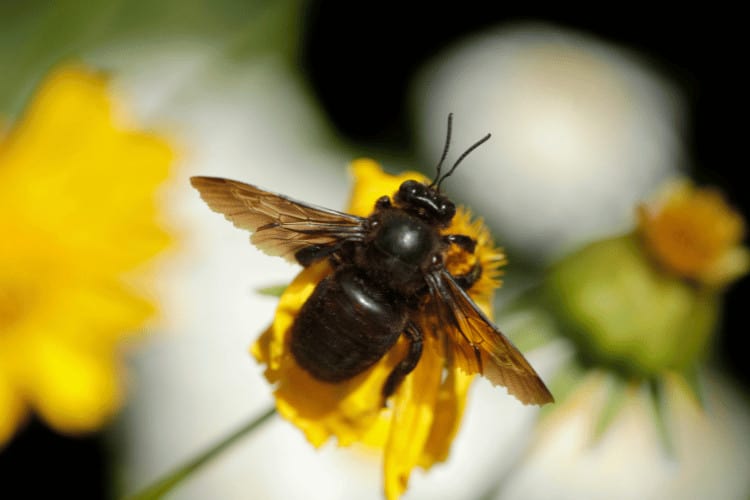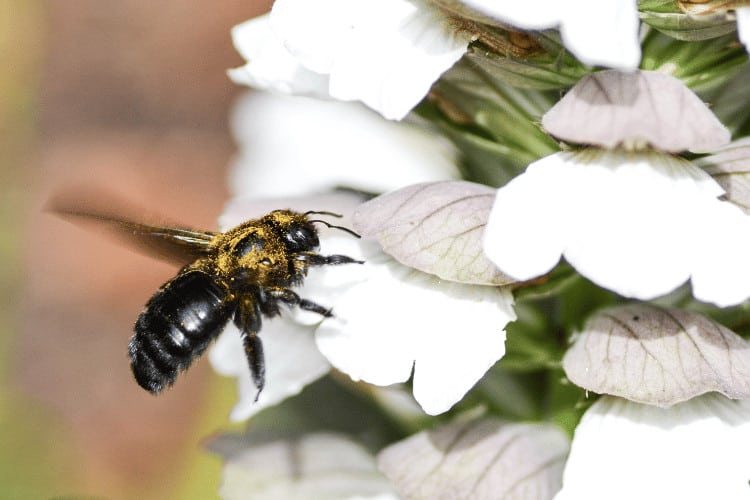Carpenter Bee vs. Wasp: How Are They Different?
As beekeepers and aspiring apiarists, it’s crucial to have a keen eye for distinguishing between different stinging insects that might coexist within your beekeeping environment.
Among the vast variety of buzzing insects, two groups that cause confusion are carpenter bees and various wasp species, including paper wasps, social wasps, and hornets.
Each of these flying insects has its unique characteristics, behaviors, and nesting habits, which can significantly impact your beekeeping efforts.
In this post, we will delve into the main differences between carpenter bees and wasps, helping you become a more informed beekeeper.
Physical Appearance

Carpenter Bees
A carpenter bee is often mistaken for a bumble bee due to its large size. However, a notable distinguishing feature is their relatively hairless and shiny abdomen.
Female carpenter bees have a jet-black appearance with a yellow strip on their thorax. These solitary bees typically range between ½ to 1 inch in length.
Wasp Species
The world of wasps encompasses a diverse range of species, each with its distinct appearance. Paper wasps, social wasps, bald-faced hornets, mud daubers, and European hornets are just a few examples.
Wasps are slimmer and more elongated than bees, with noticeable waistlines. They also tend to have brighter colors and intricate markings, such as yellow stripes or patterns on their bodies.
Nesting Habits
Carpenter Bees
Female carpenter bees are quite the industrious builders, often creating their nests within wood. These bees will bore perfectly round holes into wooden structures, using old rodent burrows or building new nesting sites.
While they’re solitary creatures, they might share the same vicinity with other carpenter bees, each tending to their own individual nest.
They often choose untreated or weathered wood, like old fences, decks, or wooden structures. By drilling into these surfaces, they create galleries where they lay their eggs and store pollen for their young.
Wasps Species
The nesting preferences of wasp species can vary widely. Paper wasps construct nests from a paper-like substance made from chewed wood fibers mixed with saliva. Wasp nests are typically attached to protected surfaces.
Hornets, such as the European hornet, build large aerial nests from the same papery material. Mud daubers create mud tubes to house their young, often attaching them to walls, eaves, or other sheltered locations.
Stinging Behavior
Carpenter Bees
Carpenter bees are generally docile and rarely sting unless they’re provoked or directly handled. This is especially the case with female carpenter bees.
Female carpenter bees possess stingers, but they’re less likely to use them, which makes them less of a threat to humans and animals. Their primary concern is protecting their nest, so avoid quick movements around their nesting sites.
Wasp Species
Many wasp species are more aggressive when it comes to stinging behavior. Social insects, like paper wasps and hornets, are known for their territorial defense and might sting if they perceive a threat to their nest.
While solitary wasps like mud daubers and solitary hunting wasps can sting if provoked, they’re usually less aggressive compared to their social counterparts.
Allergic Reactions

Carpenter Bees
Carpenter bee stings are typically mild and do not pose a notable risk to most people. That said, as with all stinging insects, some people might experience localized pain, swelling, and redness at the sting site.
Allergic reactions are rare, but if you notice signs of a severe reaction, seek medical attention as quickly as possible.
Wasp Species

Wasp stings range from mild to severe, and some people may be allergic to their venom. Social wasps such as yellow jackets and hornets can deliver painful stings, and their stings might lead to more intense allergic reactions.
If you or someone else displays signs of an allergic reaction, like difficulty breathing or swelling of the face and throat, seek emergency medical care immediately.
Concerns
Carpenter Bees
Carpenter bees are native to many regions and play a role in pollination.
While their drilling activities can sometimes damage wooden structures, they’re generally not considered invasive pests.
Wasp Species
Certain wasp species, mainly invasive ones, can have more noticeable impacts on ecosystems.
For example, the European hornet is an invasive species in North America. It can compete with native insects for resources, potentially disrupting local ecosystems.
FAQs
Are carpenter bees harmful to structures?
Carpenter bees can cause damage to wooden structures over time by drilling perfectly round holes to create their nests.
While the structural damage caused by individual carpenter bees is minimal, repeated nesting activity can weaken wood and attract woodpeckers, which can further exacerbate the damage.
Are carpenter bees aggressive?
Male carpenter bees appear aggressive as they fly around people and other perceived threats, but they lack a stinger and are essentially harmless.
Female carpenter bees have stingers but are generally not aggressive and only sting if they feel directly threatened.
Do all wasps sting?
While most types of wasp species are capable of stinging, not all of them are aggressive.
Some species of wasps are solitary and rarely come into contact with people, while others, like paper wasps and hornets, can become aggressive if their nests are disturbed.
Yellow jackets are particularly known for their aggressive behavior.
Wrapping Up
While carpenter bees tend to be less aggressive and are valuable pollinators, wasps can exhibit varying levels of aggression and potential risks.
Understanding these differences enables you to coexist with these creatures harmoniously while safeguarding your bees, yourself, and your surroundings.
Always remember to approach stinging insects with caution and respect, and seek professional assistance if you encounter challenges beyond your expertise.
